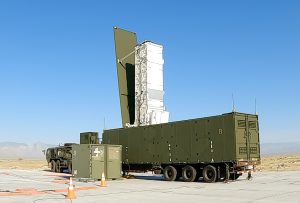China’s foreign minister said that the U.S. deployment of intermediate-range missiles in the Philippines “undermines regional peace and stability,” as tensions continue to simmer in the South China Sea.
Speaking to South Korean Foreign Minister Cho Tae-yul in New York on Saturday, Reuters reported, Wang Yi said that the deployment of the Typhon missile system, which can be equipped with cruise missiles capable of striking Chinese targets, “is not in the interests of regional countries.”
The U.S. military deployed the land-based Typhon missile system to the northern Philippines in April, ahead of the Balikatan military exercises with Philippine troops, and then left it in place after the conclusion of the exercises in May. The deployment came amid growing tensions over parts of the hotly contested South China Sea, which have seen Philippine and Chinese coast guards clash over disputed features in the Spratly Islands.
The Typhon system, which is reportedly deployed in Laoag in northern Luzon, facing the South China Sea, can fire Standard SM-6 and Tomahawk land attack missiles. The latter have a range of 1,600 kilometers, capable of striking targets in mainland China.
The continued deployment of the missile launcher is just President Ferdinand Marcos Jr.’s latest stepwise deepening of security cooperation with the U.S., which has been both a response and a spur to China’s growing maritime assertiveness in the South China Sea. Since taking office in mid-2022, the Marcos administration has initiated joint maritime patrols with the U.S. and other partners, and expanded the U.S. military’s access to Philippine military facilities under the 2014 Enhanced Defense Cooperation Agreement.
In recent months, China has repeatedly protested the deployment through numerous channels, stating that it could have a destabilizing effect on the region. Foreign Ministry spokesperson Lin Jian told a press briefing on September 19 that the deployment “seriously threatens the security of regional countries and intensifies geopolitical confrontation.”
Despite a Philippine official stating that the system would be removed by the end of this month, U.S. and Philippine security officials have since reportedly decided to keep the system in place at least until next year’s Balikatan exercise. Reuters also reported on September 20 that the two nations intended to keep the system in the northern Philippines indefinitely.
“If ever it will be pulled out, it is because the objective has been achieved and it may be brought (back) in after all the repairs or the construction would have been done,” it quoted a senior government official as saying. The official also told Reuters that the U.S. and Philippines were testing the feasibility of using the land-based missiles in Luzon in the event of a conflict, presumably with China.
The official added that it could function as a valuable deterrent against China. “We want to give them sleepless nights,” the official said.
Late last week, the Chinese state media tabloid Global Times published an article restating, in its typically colorful manner, Beijing’s claims that the missile system could only increase tensions with China.
“Right now,” it stated, “the Philippines believes the U.S. is offering it sweets, but what the U.S. actually provides is toxic, poisoning the Philippines’ relations with China and other regional countries as well as undermining regional peace.”
While it can be argued that the Philippines only stands to lose from a future conflict between the U.S. and China, and that U.S. involvement in the South China Sea equation complicates the disputes, Philippine officials can rightly point out that if China was truly interested in peace, it would take steps of its own to stabilize the situation in the region.
“Before they start talking, why don’t they lead by example?” Defense Secretary Gilberto Teodoro Jr. told reporters last week. “Destroy their nuclear arsenal, remove all their ballistic missile capabilities, get out of the West Philippines Sea and get out of Mischief Reef. I mean, don’t throw stones when you live in a glass house.”

































